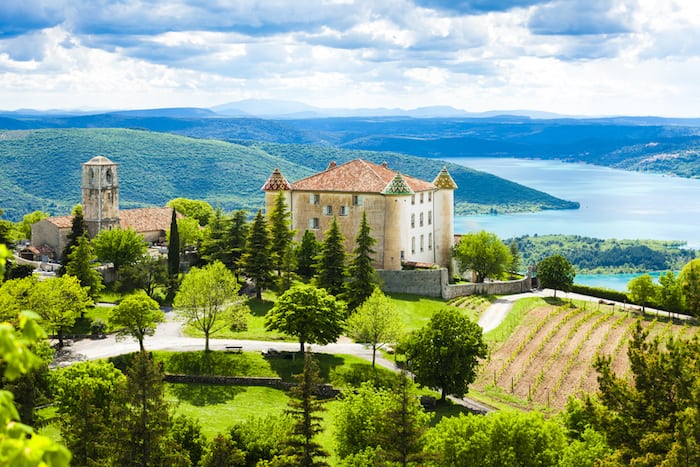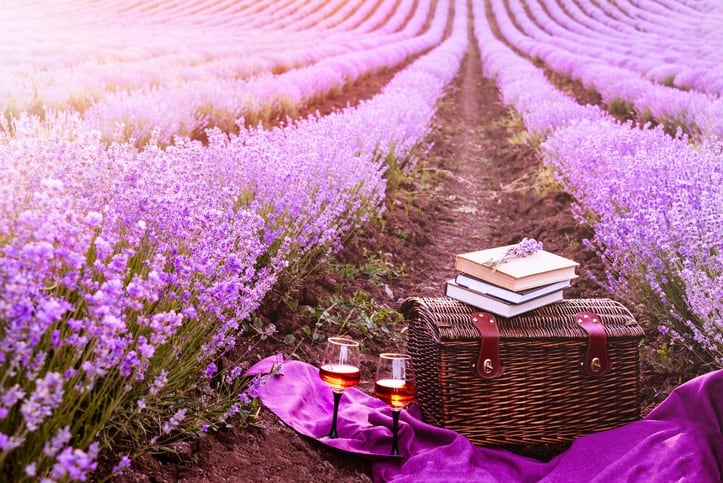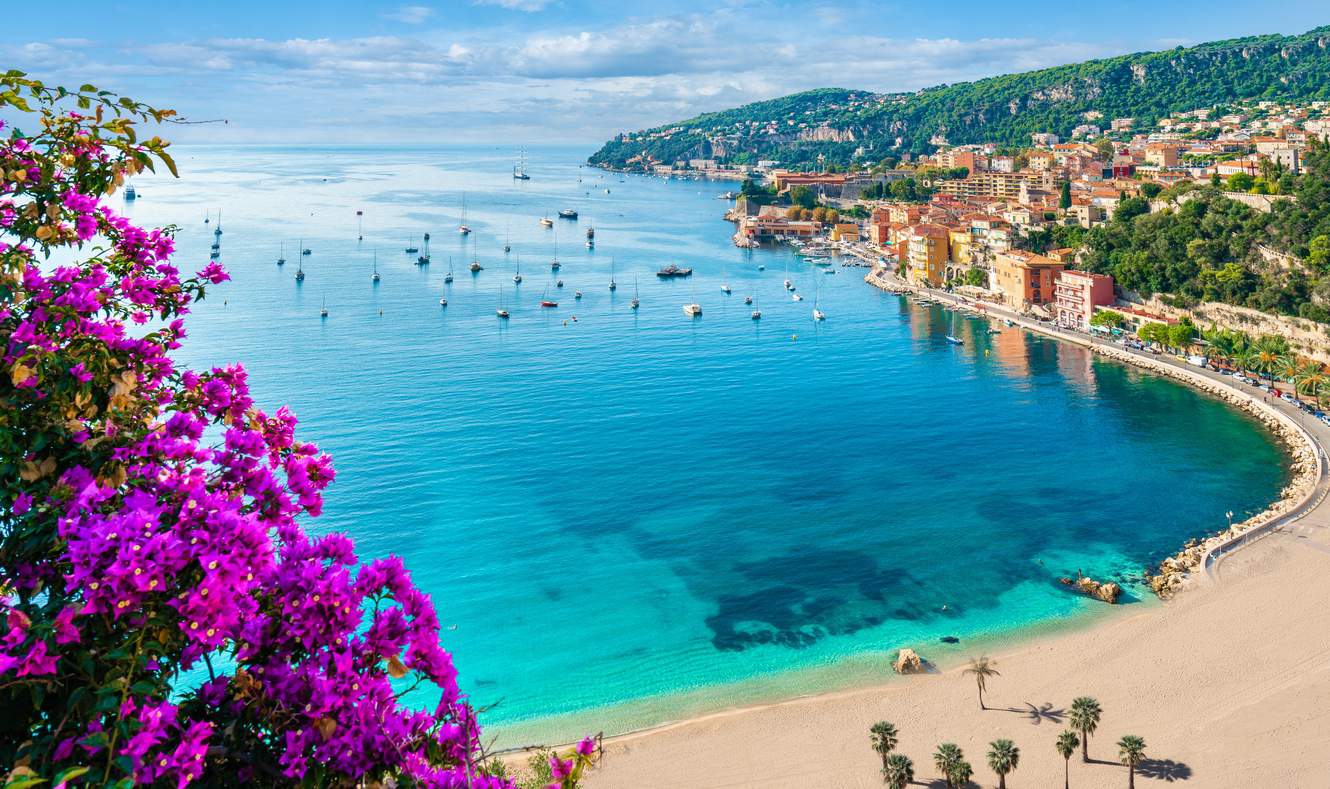Last Updated on September 6, 2023.
When thinking of Provence, the mind conjures up images of lavender fields casting purple hues on rolling hills that match the sunsets. You think of the famous sun-drenched seaside towns of the French Riviera like Nice, Cannes, Saint Tropez, Monaco and Marseille. Pale pink hues of glasses of Rosé sparkle against the back drop of the crystal blue waters of the Cote D’Azure.
Provence has a rich history in making wine. In fact, it is the oldest wine producing region in the country — producing wines for over 2600 years. The Phocaean Greeks founded modern day Marseille, bringing with them vines and wines during the 6th century BC as grapes were planted throughout the region.
Today, Provence is made up of 8 AOC’s (Appellation d’origine Contrôlée, regulated sub-regions), and wine production is 88% Rosé and growing!

Grape Varieties Used to Make Rosé in Provence, France
What constitutes a classic Provencal Rosé wine? What grape varieties go into these wines?
Provence has a number of major grape varietals grown throughout the region. For red wine, these grapes include Mourvedre (the main grape used for wine production here), Grenache Noir, Syrah, Carignan, Cinsault, Counoise, Taniat and Cabernet Sauvignon. The white grape varietals grown are Grenache Blanc, Rousanne, Marsanne, Clairette, Bourbulene, Ugni Blance or Trebbiano and Rolle or Vermentino.
Provence has ideal grape growing conditions with its Mediterranean climate. Mild winters are followed by very warm summers with little rain fall and a significant amount of sun. In fact, this area receives double the hours of sunlight needed for grapes to grow and ripen at more than 3,000 hours of sun per year.
The Mistral winds play an important role in creating the climate of Provence and assisting with keeping the vineyards dry. This helps reduce occurrences of phylloxera by fending off bugs and pests. The winds are essentially Mother Nature’s natural pesticide!
The terroir and soil make up in Provence differs in so many ways, helping to make the wines from this region so unique. With relatively no uniformity, the lands contain limestone mostly in the West, crystalline schist and granite in the East, in addition to clay, sandstone and some volcanic soils.
RELATED: A Wine Traveler’s Guide to Visiting France’s Champagne Region
The Geography & Tasting Notes of Provence
The southernmost boarder backs up to the Cote d’Azure, and in the East you have prime growing conditions on the slopes of the Alpes-de-Haute-Provence. Vines planted on the south facing slopes are offered protection from the damaging winds that can be created by the mistrals highest winds, whilst facing the seaside absorbing the sea’s spray.
One of the most predominant features that can be found in the wines made from this region is the unmistakable aromatic bouquet of lavender, juniper, thyme and rosemary — also known as Garrigue or Maquis. Other defining notes can be that of wild strawberry, raspberry, wet slate, mint, salted watermelon and candied grapefruit.
With its dreamy terrior, sun kissed skin hued wines, and rolling plains wafting of sensual herbs, Provence makes for one of the best and probably underrated places to produce wines!

What Rosé Wines Do You Recommend Drinking?
My go to is Fleur de Mer ‘Cotes de Provence’, Grenache, Cinsault, Syrah 2016
If you are like me and swoon over Provencal Rosé’s, consider these other regions producing ‘Pink Wines” that will make you think outside of the box.
First, drive roughly 65 miles Northwest of Marcellie. Kissing the border of the Languedoc you will find the Tavel region of France in the Cotes du Rhone, wine production here is 100% Rosé.
Tavel’s major grape varietals are similar to Provence. Cinsault and Grenache make up most of the production, followed by Syrah and Mourvedre. Here you will also find a Mediterranean climate affected by Mistral winds. In the Western part of Tavel you will find slate covered with chunky limestone. In the East, you’ll find ‘galets roules’ – round stones formed from centuries of flood waters. In the South, expect to see sandy fine-grain soils. Here the wines evoke flavors of raspberry coulee, white pepper, peach, green olive and cherry.
Other regions around the world are also making fantastic Provencal-style Rosé’s!
Try the Chateau de Trinquevedel, Grenache, Cinsault, Clairette, 2015
Let’s take a boat 90 miles from the Italian boarder into the Mediterranean Sea to the Isle of Corsica. The island is a territorial collective of France, but for many years it belonged to Italy. Many of the region’s winemaking traditions and grape varieties are Italian in origin.
Corsica’s terrain is mountainous, with soils rich in schist, granite, chalky limestone and clay. Most of the islands vineyards are perched along the coastlines. The vines receive an ideal amount of sun per year, at about 2,750 hours.
Major grape varitals grown here are the Nielluccio (ancestor of the Sangeovese), Grenache, Sciacarello and Vermentino. These Rosé’s are produced in the Saignee method. Corsican wines are unlike any you have had with the same grape make up. These wines have notes of green olive brine, fig, chamomile and plum.
My favorite Rosé is from Maestracci ‘E Prove’, Nielluccio and Sciacarello 2014
Let’s now make our way to the Russian River Valley in Sonoma County California. Soils here consist of sandstone, loam – “Goldridge soil”, clay and alluvial.
Resting in the heart of Sonoma County near the rugged terrain of the Pacific Ocean you will find the Russian River Valley. This region is known for warm day time temperatures and brisk evening fog rolling off of the Petaluma Gap. Sonoma is famous for its Chardonnay and Pinot Noir, and arguably put the New World on the map for these varietals.
Try the Inman Family ‘Endless Crush’, Pinot Noir of Rosé 2017
It’s loaded with notes of wild Strawberry, watermelon, ruby grapefruit and honeysuckle.
Written By Maggie Campbell
Caroline is from California but got into wine while at university at Oxford. As a wine nerd, she did competitive blind tasting and was Top Taster in the 2009 Oxford Cambridge Varsity Blind Tasting Match, judged by Jancis Robinson and Hugh Johnson. Caroline has her WSET 4 Diploma and has worked in sales, wine publishing, retail, and now runs educational wine tastings in English for expats and tourists in Lyon, France. She loves Lyon because she can be in Côte-Rôtie in 30 minutes. Her goal as a wine educator and wine writer is to make wine fun and interesting without being snobby about it. She misses London’s dynamic wine market, but loves discovering France’s more esoteric grapes and regions.


